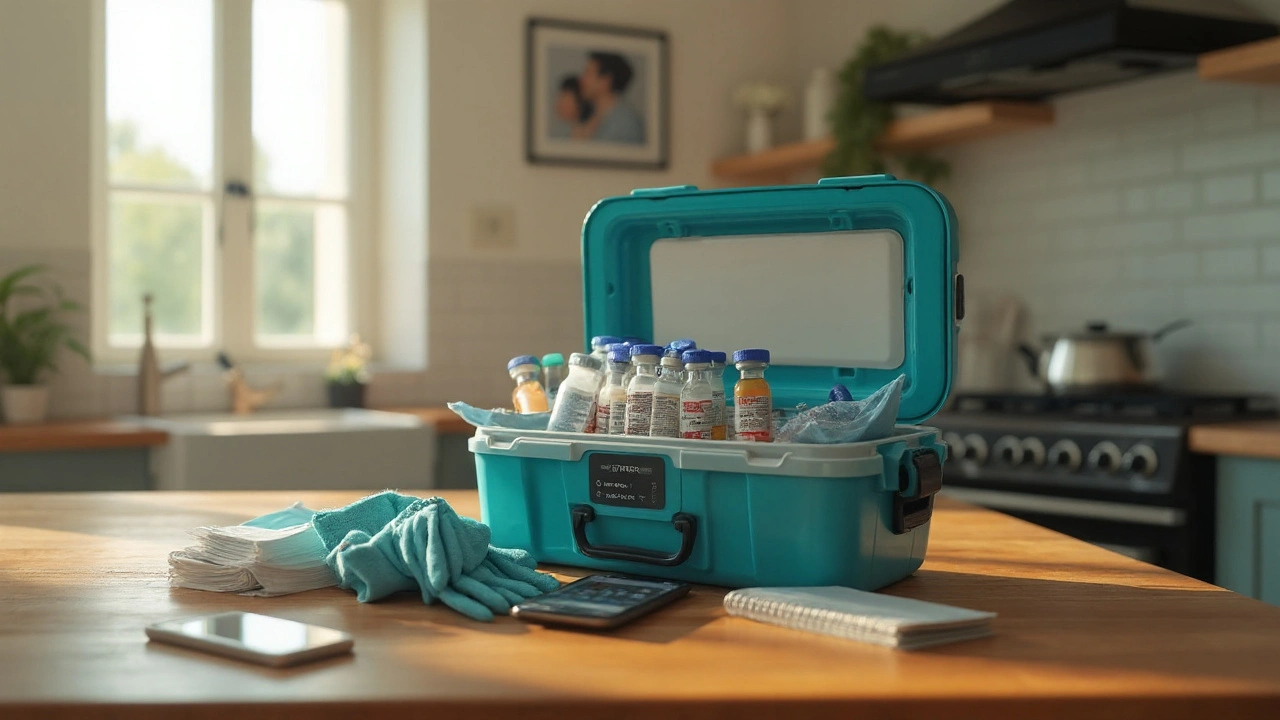
Hemophilia emergency preparedness is a proactive plan that ensures individuals with hemophilia receive life‑saving treatment quickly when bleeding emergencies strike. It combines medical resources, clear communication steps, and regular rehearsals so that a sudden bleed never catches a family off guard.
Understanding Hemophilia
Hemophilia is a genetic bleeding disorder caused by deficient clotting factors, most commonly Factor VIII (hemophilia A) or Factor IX (hemophilia B). Without these proteins, even minor injuries can turn into prolonged bleeds, making rapid access to replacement therapy essential.
Worldwide, the World Federation of Hemophilia estimates about 400,000 people live with the condition, and roughly 30% experience severe bleeds that demand emergency care.
Why an Emergency Plan Matters
In an urgent situation, every minute counts. Emergency medical services (EMS) may not carry specific clotting factor concentrates, and delays can lead to joint damage or life‑threatening hemorrhage. A well‑structured plan bridges that gap, giving responders clear instructions and ensuring the right product gets to the patient without hesitation.
Key outcomes of a solid plan include:
- Reduced time to first dose of factor concentrate.
- Lower risk of complications such as hemarthrosis.
- Peace of mind for patients, families, and schools.
Building the Ideal Emergency Kit
The heart of any preparedness strategy is a reliable kit. Below are the essential items, each introduced with its own entity definition.
Factor VIII (recombinant or plasma‑derived) is the primary replacement therapy for hemophilia A. Typical dosing for a severe bleed ranges from 40‑60 IU/kg, administered intravenously.
Factor IX serves the same purpose for hemophilia B, with a standard dose of 80‑100 IU/kg for major bleeds.
Antifibrinolytic medication, such as tranexamic acid, helps stabilize clots when factor replacement is insufficient, especially in mucosal bleeding.
Emergency medical services (EMS) are the first responders who may be called to administer life‑saving care. Providing them with a concise briefing sheet speeds up decision‑making.
Patient emergency card is a wallet‑size card that lists diagnosis, factor product, dosing information, and contact details for the treating hemophilia centre.
Portable factor concentrate kit contains pre‑measured vials, sterile tubing, and a compact infusion pump, all packaged for easy transport.
Medical alert bracelet provides an immediate visual cue to responders that the wearer has a bleeding disorder and needs factor replacement.
Home infusion therapy training equips patients or caregivers to self‑administer factor concentrates, reducing reliance on hospital infusion centres during crises.
Creating a Personal Emergency Action Plan
- Identify the primary contact at your regional hemophilia centre and obtain a 24‑hour on‑call number.
- Store factor concentrates at two locations: home and a secondary site (e.g., a parent’s house or workplace).
- Write a one‑page briefing for EMS that includes diagnosis, factor type, dose calculation, and allergy information.
- Practice the infusion steps with a trainer kit at least once a month.
- Review and replace expired products quarterly; rotate stock using the “first‑in‑first‑out” method.
Coordinating with EMS and Healthcare Providers
Before any emergency occurs, reach out to your local ambulance service. Many UK trusts have a designated “Bleeding Disorder Liaison” who can be added to the dispatch system. Provide them with a copy of the patient emergency card and a pre‑written script that reads:
"This is a case of hemophilia A. Administer 50IU/kg of recombinant Factor VIII immediately and call the haemophilia centre at [phone]."
Confirm that the liaison knows where your portable kit is stored and how to access it.

Training Family, School, and Workplace
Everyone who might be present during a bleed should know three things:
- How to recognize a serious bleed (e.g., swelling, pain, uncontrolled bruising).
- Where the emergency kit is located.
- How to call EMS and relay the briefing information.
Run a short simulation every six months. The practice not only builds confidence but also highlights gaps-maybe the kit is hidden behind a locked cabinet or the contact number is outdated.
Maintaining and Updating Your Plan
Hemophilia care evolves fast. New long‑acting factor products, gene‑therapy trials, and updated dosing guidelines appear regularly. Schedule an annual review with your haemophilia specialist to:
- Confirm the factor product in the kit matches the latest prescription.
- Update the emergency card with any new allergies or comorbidities.
- Refresh the EMS briefing sheet to reflect any changes in local protocols.
Related Concepts and Next Steps
While the emergency kit handles immediate treatment, broader topics support long‑term safety:
- Genetic counseling helps families understand inheritance patterns and plan future testing.
- Blood bank coordination ensures that if factor concentrates run out, compatible plasma can be sourced quickly.
- Coagulation clinic follow‑up monitors inhibitor development, a rare but serious complication that can render standard factor therapy ineffective.
After you’ve set up the core plan, explore these adjacent areas to round out your preparedness strategy.
Comparison of Emergency Kit Options
| Kit Type | Contents | Weight (kg) | Shelf Life (months) | Approx. Cost (£) |
|---|---|---|---|---|
| Standard Emergency Kit | Factor concentrate, saline, tourniquet, gauze, emergency card | 1.2 | 12 | 850 |
| Portable Factor Concentrate Kit | Pre‑filled factor vials, compact infusion set, battery‑powered pump, QR‑code briefing sheet | 0.6 | 18 | 1,200 |
For most families, the Standard Emergency Kit provides a solid baseline. Users who travel frequently or need rapid, hands‑free administration may find the Portable Kit worth the extra investment.
Next Steps for Immediate Action
- Print and laminate the patient emergency card.
- Purchase a portable infusion pump if you haven’t already.
- Call your local EMS liaison to add your briefing sheet to their system.
- Schedule a training session with your haemophilia centre within the next month.
- Set a calendar reminder for quarterly kit inspections.
Taking these steps now turns a theoretical plan into a living safety net you can rely on the moment a bleed occurs.

Frequently Asked Questions
What should I do if I run out of factor concentrate during a bleed?
First, call emergency services and give them the briefing script. While waiting, apply direct pressure and elevate the affected limb. Simultaneously, contact your haemophilia centre; most UK centres have a 24‑hour on‑call line that can arrange urgent delivery of replacement factor or authorize use of a nearby hospital’s blood bank.
Do ambulances carry factor VIII or IX?
Generally, UK ambulance services do not stock specific clotting factor concentrates. However, many trusts have a pre‑arranged protocol that allows paramedics to request the product from a local hospital pharmacy or to coordinate rapid delivery from the patient’s own kit.
How often should I replace the factor in my emergency kit?
Check the expiration date on each vial quarterly. Most factor concentrates have a 12‑ to 18‑month shelf life when stored at 2‑8°C. Use a “first‑in‑first‑out” rotation and replace any product that is within six months of expiring.
Can children carry their own emergency kit?
Yes, but the kit should be sized for a child’s backpack and include age‑appropriate instructions. Teach the child to alert an adult immediately and to hand over the kit rather than attempt self‑infusion unless they have been specifically trained and are comfortable doing so.
What role does a medical alert bracelet play in an emergency?
The bracelet provides a quick visual cue to bystanders and EMS that the wearer has a bleeding disorder. Modern bracelets often include a QR code that links to a secure webpage with the patient’s factor type, dosing protocol, and emergency contact numbers.
Is home infusion therapy safe for emergencies?
When patients receive proper training from a haemophilia centre, home infusion is safe and often faster than waiting for hospital assistance. Keep the infusion set sterile, follow the exact dosage calculations, and have a backup plan (EMS contact) if complications arise.

11 Comments
Ugh, reading this feels like watching a drama where the hero forgets their own cape-why do we have to keep reminding ourselves that a simple bleed can turn into a nightmare if we don't have that stupid kit ready?
Seriously, this whole emergency plan is just a bureaucratic excuse for the government to waste money on pointless paperwork.
First, let me say that taking the time to build an emergency plan is a commendable act of responsibility, especially when living with a condition as demanding as hemophilia; it shows you care not only for yourself but for everyone who might be called upon in a crisis. Second, the checklist you outlined covers the essential components, from factor concentrates to the emergency card, and that level of detail can dramatically reduce the response time when a bleed occurs. Third, remember that rehearsing the infusion steps with a trainer kit on a regular basis creates muscle memory, which is priceless when adrenaline spikes and your hands might shake. Fourth, maintaining a “first‑in‑first‑out” rotation for your supplies ensures you never run out of viable medication, and the quarterly inventory check you mentioned is a smart habit that many families overlook. Fifth, establishing a direct line to your hemophilia centre, complete with a 24‑hour on‑call number, builds a safety net that can be activated at any hour, which is critical because bleeds do not keep office hours. Sixth, the inclusion of a concise EMS briefing sheet is a brilliant move; paramedics often lack specialized knowledge, and a one‑page script can save minutes that translate into saved joints. Seventh, the recommendation to have a secondary storage site, such as a parent’s house or workplace, adds redundancy that protects against unforeseen events like a power outage or a natural disaster. Eighth, training not just family members but also teachers and coworkers creates a community of informed responders, turning a potential emergency into a coordinated effort. Ninth, the idea of a QR‑coded medical alert bracelet merges technology with practicality, allowing responders to access up‑to‑date information instantly. Tenth, staying abreast of evolving therapies, such as long‑acting factor products or gene‑therapy trials, will keep your plan relevant as the field advances. Eleventh, scheduling an annual review with your specialist is not merely a formality; it is an opportunity to fine‑tune dosing protocols based on your latest health data. Twelfth, remember that emotional support for the patient and family is just as important as the medical logistics, because stress can exacerbate bleeding risks. Thirteenth, you might consider keeping a small “panic” pouch in your bag for situations when you cannot reach the main kit, containing a pre‑filled syringe and a quick‑reference card. Fourteenth, the emphasis on clear communication-knowing exactly what to tell EMS-cannot be overstated, as miscommunication can lead to dangerous delays. Fifteenth, by integrating all these elements into a living document that you review and practice, you transform a theoretical plan into an actionable, life‑saving strategy. Finally, keep sharing your experiences with the wider hemophilia community; collective wisdom builds stronger safety nets for everyone.
When you look at the overall structure of an emergency plan, you can see it as a series of interconnected modules, each supporting the other, and that perspective helps you identify where you might need extra reinforcement; for instance, if you notice that the briefing sheet for EMS is getting lost in paperwork, you could digitize it and store it on a secure cloud platform that the paramedics can access with a simple code. By practicing the infusion steps in a low‑stress environment, you build confidence, and that confidence translates into quicker, more accurate administration when time is of the essence. Moreover, involving school personnel early on creates a safety culture that extends beyond the home, and the routine drills you run every six months become not just exercises but habit‑forming rituals that embed the response protocol into the collective memory of everyone involved. It's also worth noting that having a secondary stock of factor at a relative’s house adds a layer of redundancy, which is the hallmark of any robust emergency system. Finally, keep an eye on the evolving guidelines from the World Federation of Hemophilia, because staying current ensures that your plan remains aligned with best practices worldwide.
Oh, absolutely, because nothing says “I’m prepared for a life‑threatening bleed” quite like a spreadsheet of contact numbers printed on glitter paper and a PDF that only your tech‑savvy teenage niece can actually open; it’s almost as if we’re expecting the emergency services to pull out a MacBook on the back of an ambulance. Yet, on a more serious note, the idea of redundant storage locations is sound, but let’s not forget that a locked cabinet can become a literal barrier when seconds count, so perhaps a more accessible yet secure solution-like a tamper‑evident lockbox-might be worth considering. Also, while you champion digital briefings, remember that not every paramedic unit has reliable internet access in rural areas, so a concise, printed one‑pager remains indispensable. And let’s be honest, conducting drills every six months often turns into a “forgotten Saturday morning” event, so maybe integrating a quick “refresher flashcard” into the family’s routine could keep the steps fresh without the logistical headache of a full‑scale simulation. In short, the plan is great on paper, but the devil, as always, is in the details that we sometimes overlook in our enthusiasm.
The emergency card should include your specific factor type, dosage calculations based on weight, and a direct line to your hemophilia centre; keeping it laminated protects it from wear and tear, and storing a digital copy in a secure cloud service ensures you can retrieve it if the physical card is misplaced.
Picture the emergency card as your superhero cape-bright, unmistakable, and always ready to swoop in when danger looms; by adding a QR code that sparkles with your latest treatment protocol, you give first responders a fast‑track ticket to the right therapy, turning a potentially chaotic scene into a well‑orchestrated rescue dance.
When we contemplate preparedness, we are essentially sculpting the future we hope to inhabit; there is profound dignity in taking proactive steps that honor both our own lives and the collective responsibility we share with caregivers, medical teams, and society at large, and this mindset should underpin every element of your emergency strategy.
Imagine the moment a bleed strikes like a thunderclap in a silent night; without a well‑rehearsed plan, that thunder becomes a deafening roar, but with the right kit and clear communication, you can transform that roar into a gentle rain that nourishes healing rather than fracturing bones.
i think its super important to have a backup kit at work too, cuz you never know when a bad day at the office might turn into a bleed crisis and having the stuff right there can save you a ton of stress.
Having a secondary kit at your workplace not only provides peace of mind but also enables swift action, especially if your primary kit is temporarily inaccessible; just be sure to inform a trusted coworker about its location and check the expiration dates regularly.